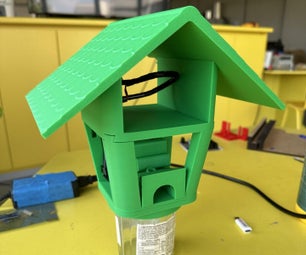Introduction: DIY Dirt Cheap Continuity Tester With LED + 555 IC
Hi, i wanted to have a continuity tester (my multimeter doesn't have a buzzer) so i don´t have to look away from the circuit I am testing to see the multimeters display. Although i wanted a buzzer i also added a LED and an on/off switch for late night tinkering "stealth mode"
I don´t have any engineering or electronics background (actually i am a surgeon), but i love to make stuff and i am self teaching electronics with the help from Google and instructables.com . This is my first instructable and English isn´t my native tongue, so bear with me please...
DISCLAIMER: If following this guide anything/anyone/yourself damages i shall not be held responsible.Do it at your own risk. Take all the safety measures (goggles, gloves, etc)
I don´t have any engineering or electronics background (actually i am a surgeon), but i love to make stuff and i am self teaching electronics with the help from Google and instructables.com . This is my first instructable and English isn´t my native tongue, so bear with me please...
DISCLAIMER: If following this guide anything/anyone/yourself damages i shall not be held responsible.Do it at your own risk. Take all the safety measures (goggles, gloves, etc)
Step 1: Bill of Materials:
-Highlighter (worn out)
-Pen
-Blue LED
-switch
-555 IC
-0.01uF ceramic capacitors= 2
-1uF electrolitic capacitor = 1
-180 k resistor = 1
-56 k resistor= 1 (i did it on the weekend with no opened stores, so i used 47k + 10k series resistors)
-Piezo buzzer= 1 (i used a Hycom HY-07 that i took from an old modem)
-Button cell batteries= 3
-Battery holder (from a cheap-o pen/flashlight i had)
-Wires
-Soldering Iron
-hot glue gun
-xacto knife
-Pen
-Blue LED
-switch
-555 IC
-0.01uF ceramic capacitors= 2
-1uF electrolitic capacitor = 1
-180 k resistor = 1
-56 k resistor= 1 (i did it on the weekend with no opened stores, so i used 47k + 10k series resistors)
-Piezo buzzer= 1 (i used a Hycom HY-07 that i took from an old modem)
-Button cell batteries= 3
-Battery holder (from a cheap-o pen/flashlight i had)
-Wires
-Soldering Iron
-hot glue gun
-xacto knife
Step 2: Let the Stripping Begin..
First of all, i took apart the highlighter, threw away the tip and the ink cartridge by cutting the back end with an xacto knife. And i did the same to the flashlight/pen in order to take the battery holder away.
Step 3: Test 1,2,3
I found a buzzer circuit ( http://electronic-circuits-diagrams.com/alarmsimages/alarmsckt5.shtml ) the easiest and simple circuit i could find and tried it on the breadboard. It worked out fine, except i changed de 10k resistor (pins 7 and 8 of the 555 IC) for a 180k resistor because i liked the tone better.
Step 4: Avengers Assemble
i soldered all together over the 555 directly trying to make it as compact as possible (although i had plenty of room inside the highlighter, i did that way just in case i want to house it in a smaller pen someday)
Step 5: Adding the LED, Buzzer and Switch
-I stuffed some solder with the wires into a BIC pen tip (it´s a little messy because of the ink) and heated them with the soldering iron. -Then wired the tip to the (-) leg of the led and the pin 1 of the 555 IC.
-The (+) leg of the LED and the pin 4 of the 555 (through the on/off switch) to the positive pole of the battery pack.
-The secondary probe (another used pen) with a wire wrapped around the tip to the negative pole of the battery pack
When the two probe tips touch each other (or through a conductive material such as a wire or a circuit track) the circuit closes and the LED lights up and the buzzer vibrates with a nice tone.
The buzzer can be turned off with the switch, while the LED still lights up with continuity.
-The (+) leg of the LED and the pin 4 of the 555 (through the on/off switch) to the positive pole of the battery pack.
-The secondary probe (another used pen) with a wire wrapped around the tip to the negative pole of the battery pack
When the two probe tips touch each other (or through a conductive material such as a wire or a circuit track) the circuit closes and the LED lights up and the buzzer vibrates with a nice tone.
The buzzer can be turned off with the switch, while the LED still lights up with continuity.
Step 6: Mounting the Switch, the Buzzer and the Battery Holder
-I made a hole at one side of the highlighter so i can install the small switch i had
The buzzer and the battery holder are housed in the cap that clips on the end (that was reattached with a hole so wires can pass through and hot-glued). This allows me to change the batteries when they die.
The buzzer and the battery holder are housed in the cap that clips on the end (that was reattached with a hole so wires can pass through and hot-glued). This allows me to change the batteries when they die.
Step 7: Continuity Tester Completed
Everything in place, time for the last step
Step 8: It�s Alive!!
Testing, everything do what it should be doing.
You can see the LED light (obviously you can´t hear the buzzer), maybe later i upload a video.
You can see the LED light (obviously you can´t hear the buzzer), maybe later i upload a video.
Step 9: Final Thoughts
You could use smaller components in order to fit everything into a smaller pen o skip the buzzer part and built a led crcuit.

Participated in the
Make It Glow

Participated in the
Instructables Design Competition

Participated in the
Pocket Sized Contest









